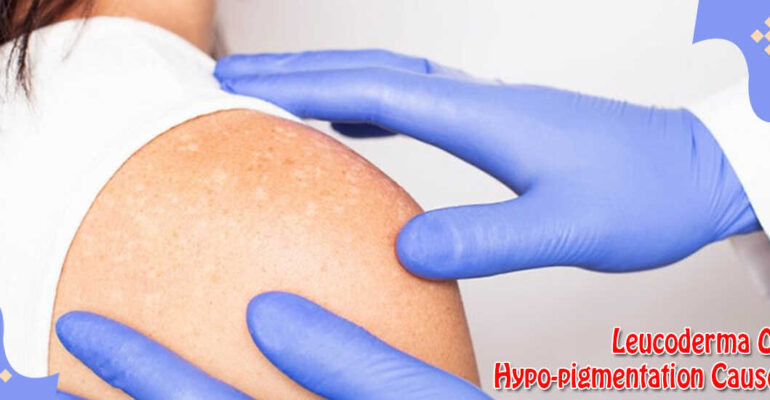Leucoderma Or Hypo-pigmentation Causes
August 25, 2021 2021-08-25 7:38Leucoderma Or Hypo-pigmentation Causes
As an Amazon associate, Dermatocare earns from valid purchase made by clicking on the affiliate links in this blog.

Leucoderma Or Hypo-pigmentation Causes
Written By Dr Surbhi, MD Skin
Last updated: 24/07/21
“Doctor, What is Leucoderma Or Vitiligo or Hypopigmentation?” These three terms are often used interchangeably by layman, however to dermatologist they have different meanings. Leucoderma or hypopigmentation or hypomelanosis means partial or total loss of skin color, that is visible as light brown to white patches on your skin. Vitiligo is one of cause behind getting leukoderma.
The color of your skin is due to the presence of melanin pigment formed by the special cells called melanocytes. Leucoderma or hypopigmentation or hypomelanosis occurs when there is loss or reduction in either number or function of melanin or melanocytes. There are innumerable causes of leucoderma or hypopigmentation or hypomelanosis, we have listed the common ones here:
COMMON CAUSES IN CHILDHOOD:
-
- Nevus depigmentosus presents as localised asymptomatic white patch with regular or serrated borders in early childhood.
- Piebaldism is autosomal dominant inherited disorder that also presents as leukoderma in childhood, however the charactristic feature is white forelock of hair and presence of hyperpigmented/darker areas in between the depigmented and normal skin.
- Albinism is congenital disorder characterized by partial or complete absence of melanin not only in skin and hair, but also eyes.
- Pityriasis alba presents as white patches with indistinct border & fine scaling mostly on face, for details read this arcticle.
COMMON CAUSES IN ADULTS:
- Vitiligo is acquired often progressive disorder of hypopigmentation, discussed in details by me in another article.
- Idiopathic guttate hypomelanosisis presents with small white to light brown patches on shins and forearms in females beyond the age of 40 years.
- Tinea versicolor is caused by yeast, and is characterised by small white patches with fine scales on the surface mostly distributed on the upper back and chest.
- Post inflammatory hypomelanosis as the name suggests ocurs as a result of damage to the pigment forming cells in various skin disorders like psoriasis, herpes zoster, secondary syphillis, sarcoidosis, mycosis fungoidosis etc.
- Post-traumatic leukoderma occurs when the pigment forming cells are damaged due to any kind of physical trauma to skin like accidents, ulcers, burns etc.
- Pressure leukoderma occurs due to constant pressure on skin for prolonged time, and is commonly seen in Indian females over waist, as a result of tightly tying a Sari.
- Chemical-induced lekoderma occurs at the site of contact of chemicals like:
- On feet: because Azo dyes in ALTS.
- On forehead because of Para-tertiary butylphenol in Bindi adhesive.
- On feet due to straps of rubber slippers.
- On feet due to straps of rubber slippers.
- Halo nevi is charectrised by development of white border around existing mole.
- Lichen sclerosis characteritically has thinning of skin in the areas white patches.
- Morphea on the other hand has thick & hard skin along with white patches.
When to see a dermatologist?
As I have already discribed that they are many causes of leucoderma or white patches on skin, a dermatologist visit is highly recommended to establish the diagnosis at the earliest. Besides, the role timely start of trematment in reversible causes of lekoderma cannot be understimated. On the other hand in the irreversible or congenital causes the detailed examination is needed to rule out involvement of internal organs and also for counselling of patient or parents.
This article is AUTHOURED BY Dr Amitoj Garg, MD Dermatology
Dr Amitoj Garg is director of Jagdamba Skin & Laser Center, Sriganganagar, Rajastan. After finishing dermatology training from Krisha Institute of Medical Sciences, he has received formal training on lasers and cosmetic surgery under the guidance of Dr Venkatraam Mysore. He has conducted presentations and has been awarded at various International, National and State conferences. He can be reached at amitoj2@gmail.com.
ROUTINE FINDER
Get free dermatologist-recommended regime by choosing your skin or concerns.

FACE

HAIRS

CHILD

BODY




